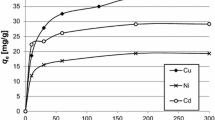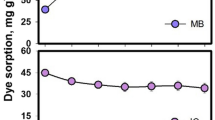Abstract
Pollution from synthetic dyes has emerged to be a significant environmental issue over the past few decades. This has mainly been triggered by the increasing global dye production, possible toxic effects, undesirable colour and high persistence in the environment. Biosorption, which involves dye removal from aqueous solution by passive linkage in live and dead biomass, has shown great potential in removing dyes from aquatic environments. Among aquatic macrophytes, water hyacinth, Eichhornia crassipes, has shown great potential as a biosorbent. In this work, we investigated the removal of two basic dyes, methylene blue and crystal violet, using E. crassipes immobilized on alginate. Results showed that the Langmuir model better described the equilibrium sorption data when compared to the Freundlich model. Optimum amounts of methylene blue and crystal violet dyes were adsorbed in the alkaline pH range (8–10), 8 % biomass dose, and the amount of dye removed increased with increasing initial dye concentration. The equilibrium monocomponent adsorption capacities for the dyes were 111.1 and 43.5 mg/g, while the binary adsorption capacities were 26.1 and 11.6 mg/g for methylene blue and crystal violet, respectively. To conclude, we show for the first time that E. crassipes fixed on alginate beads can uptake and adsorb methylene blue and crystal violet dyes very effectively in batch systems and show great potential for dye removal from aquatic environments.



Similar content being viewed by others
References
Ahmad R (2009) Studies on adsorption of crystal violet dye from aqueous solution onto coniferous pinus bark powder, (CPBP). J Hazard Mat 171:767–773
Akar T, Divriklioglu M (2010) Biosorption applications of modified fungal biomass for decolorization of Reactive Red 2 contaminated solutions: batch and dynamic flow mode studies. BioresourTechnol 101:7271–7277
Al-Degs Y, Khraisheh MAM, Allen SJ, Ahmad MN, Walker GM (2007) Competitive adsorption of reactive dyes from solution: equilibrium isotherm studies in single and multisolute systems. Chem Eng J 128:163–167
Ali H, Muhammad SK (2008) Biosorption of crystal violet from water on leaf biomass of Calotropis procera. J Environ Sci Technol 1:143–150
Bai RS, Abraham TE (2003) Studies on chromium(VI) adsorption-desorption using immobilized fungal biomass. Bioresour Technol 87:17–26
Beolchini F, Pagnanelli F, Toro L, Veglio F (2003) Biosorption of copper by Sphaerotilus natans immobilised in polysulfone matrix: equilibrium and kinetic analysis. Hydrometallurgy 70:101–112
Bergmann K, O’Konski CT (1963) A spectroscopic study of methylene blue monomer, dimer and complexes with montmorillonite. J Phys Chem 67:2169–2177
Bulut Y, Aydin H (2006) A kinetics and thermodynamics study of methylene blue adsorption on wheat shells. Desalination 194:259–267
Chen H, Zhao J, Dai G (2011) Silkworm exuviae-a new non-conventional and low-cost adsorbent for removal of methylene blue from aqueous solutions. J Hazard Mater 186:1320–1327
Crin G (2005) Recent developments in polysaccharide-based materials used as adsorbents in wastewater treatment. Prog Polym Sci 30:38–70
Daneshvar N, Ayazloo M, Khataee AR, Pourhassan M (2007) Biological decolorization of dye solution containing Malachite Green by microalgae Cosmarium sp. Bioresour Technol 98:1176–1182
Dong Y, Chen J, Li C, Zhu H (2007) Decoloration of three azo dyes in water by photocatalysis of Fe(III)-oxalate complexes/H2O2 in the presence of inorganic salts. Dyes Pigment 73:261–268
El-Khaiary MI (2007) Kinetics and mechanism of adsorption of methylene blue from aqueous solution by nitric-acid treated water-hyacinth. J Hazard Mater 147:28–36
El-Sayed GO (2011) Removal of methylene blue and crystal violet from aqueous solutions by palm kernel fiber. Desalination 272:225–232
Farooq U, Kozinski JA, Khan MA, Athar M (2010) Biosorption of heavy metal ions using wheat based biosorbents—a review of the recent literature. Bioresour Technol 101:5043–5053
Garg VK, Amita M, Kumar R, Gupta R (2004) Basic dye (methylene blue) removal from simulated wastewater by adsorption using Indian Rosewood sawdust: a timber industry waste. Dyes Pigment 63:243–250
Gessner F, Schmitt CC, Neumann MG (1994) Time-dependent spectrophotometric study of the interaction of basic dyes with clays. 1. Methylene blue and neutral red on montmorillonite and hectorite. Langmuir 10:3749–3753
Hameed BH, Mahmoud DK, Ahmad AL (2008) Sorption equilibrium and kinetics of basic dye from aqueous solution using banana stalk waste. J Hazard Mater 158:499–506
Hang PT, Brindley GW (1970) Methylene blue adsorption by clay minerals. Determination of surface areas and cation exchange capacities (clay-organic studies XVIII). Clays Clay Miner 18:203–212
He LM, Tebo BM (1998) Surface charge properties of and Cu (II) adsorption by spores of the marine Bacillus sp. Strain SG-1. Appl Environ Microbiol 64:1123–1129
Hu ZZ-C, Reeves M (1997) Biosorption of uranium by Pseudomonas aeruginosa strain CSU immobilized in a novel matrix. Biotechnol Prog 13:60–70
Kannan N, Sundaram MM (2001) Studies on the removal of rhodamine B by adsorption using various carbons—a comparative study. Fresenius Environ Bull 10:814–822
Khataee AR, Vafaei F, Jannatkhah M (2013) Biosorption of three textile dyes from contaminated water by filamentous green algal Spirogyra sp.: kinetic, isotherm and thermodynamic studies. Int Biodeterior Biodegrad 83:33–40
Kousha M, Daneshvar E, Sohrabi MS, Jokar M, Bhatnagar A (2012a) Adsorption of acid orange II dye by raw and chemically modified brown macroalga Stoechospermum marginatum. Chem Eng J 192:67–76
Kousha M, Daneshvar E, Sohrabi MS, Koutahzadeh N, Khataee AR (2012b) Optimization of C.I. Acid black 1 biosorption by Cystoseira indica and Gracilaria persica biomasses from aqueous solutions. Int Biodeterior Biodegrad 67:56–63
Lourenco ND, Novais JM, Pinheiro HM (2001) Effect of some operational parameters on textile dye biodegradation in a sequential batch reactor. J Biotechnol 89:163–174
Low KS, Lee CK, Tan KK (1995) Biosorption of basic dyes by water hyacinth roots. Bioresour Technol 52:79–83
Mahamadi C (2011) Water hyacinth as a biosorbent: a review. Afr J Environ Sci Technol 5:1137–1145
Mahamadi C, Nharingo T (2007) Modeling kinetic and equilibrium properties of cadmium biosorption by river green alga and hyacinth weed. Toxicol Environ Chem 89:297–305
Mahamadi C, Zambara P (2012) Adsorption of Cu(II) from aquatic systems using alginate-immobilized water hyacinth beads. Eur J Sci Res 71(4):581–589
Maurya NS, Mittal AK, Cornel P, Rother E (2006) Biosorption of dyes using dead macro fungi: effect of dye structure, ionic strength and pH. Bioresour Technol 97:512–521
Rao KCLN, Ashutosh KK (1994) Color removal from dyestuff industry effluent using activated carbon. Indian J Chem Tech 1:13–19
Rytwo G, Nir S, Margulies L (1995) Interactions of monovalent organic cations with montmorillonite, adsorption and model calculations. Soil Sci Soc Am J 59:554–564
Selvam PP, Preethi S, Basakaralingam P, Thinakaran N, Sivasamy A, Sivanesan S (2008) Removal of rhodamine B from aqueous solution by adsorption onto sodium montmorillonite. J Hazard Mater 155:39–44
Serpa AL, Schneider IAH, Rubio J (2005) Adsorption onto fluidized powdered activated carbon flocs-PACF. Environ Sci Technol 39:885–888
Shaw AM, Hannon TE, Li F, Zare RN (2003) Adsorption of crystal violet to the silica water interface monitored by evanescent wave cavity ring-down spectroscopy. J Phys Chem B 107:7070–7075
Vafaei F, Khataee AR, Movafeghi A, Salehi Lisar SY, Zarei M (2012) Bioremoval of an azo dye by Azolla filiculoides: study of growth, photosynthetic pigments and antioxidant enzymes status. Int Biodeterior Biodegrad 75:194–200
van den Hul HJ, Lyklema J (1968) Determination of specific surface areas of dispersed materials. Comparison of the negative adsorption method with some other methods. J Am Chem Soc 90:3010–3015
Viraraghavan T, Yuan G (2001) Heavy metal in a removal in biosorption column by immobilised M. rouxii biomass. Bioresour Technol 78:243–249
Vijayaraghavan K, Yun Y-S (2007) Chemical modification and immobilization of Corynebacterium glutamicum for biosorption of reactive black 5 from aqueous solution. Ind Eng Chem Res 46:608–617
Volesky B (2001) Detoxification of metal bearing effluents: biosorption for the next century. Hydrometallurgy 59:203–216
Wang GX (1995) Biosorption of heavy metal ions from aqueous solution by non-living water hyacinth roots. PhD thesis, University of Nevada, Reno, Reno, NV
Weng CH, Lin YT, Tzeng TW (2009) Removal of methylene blue from aqueous solution by adsorption onto pineapple leaf powder. J Hazard Mater 170:417–424
Xiangliang P, Jianlong W, Daoyong Z (2005) Biosorption of Pb(II) by Pleurotus ostreatus immobilized in calcium alginate gel. Process Biochem 40:2799–2803
Yariv S, Mueller-Vonmoos M, Kahr G, Rub A (1989) Thermal analytic study of the adsorption of crystal violet by montmorillonite. Thermochim Acta 148:457–466
Acknowledgments
The International Foundation for Science, Stockholm, Sweden, supported this research through Grant Number W/4266-2 to Courtie Mahamadi.
Author information
Authors and Affiliations
Corresponding author
Rights and permissions
About this article
Cite this article
Mahamadi, C., Mawere, E. High adsorption of dyes by water hyacinth fixed on alginate. Environ Chem Lett 12, 313–320 (2014). https://doi.org/10.1007/s10311-013-0445-z
Received:
Accepted:
Published:
Issue Date:
DOI: https://doi.org/10.1007/s10311-013-0445-z




